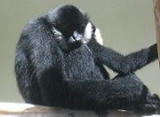The
black crested gibbon (
Nomascus concolor) is an endangered species of
gibbonGibbons are apes in the family Hylobatidae . The family is divided into four genera based on their diploid chromosome number: Hylobates , Hoolock , Nomascus , and Symphalangus . The extinct Bunopithecus sericus is a gibbon or gibbon-like ape which, until recently, was thought to be closely related...
found in
IndiaIndia , officially the Republic of India , is a country in South Asia. It is the seventh-largest country by geographical area, the second-most populous country with over 1.2 billion people, and the most populous democracy in the world...
, the
Malay archipelagoThe Malay Archipelago refers to the archipelago between mainland Southeastern Asia and Australia. The name was derived from the anachronistic concept of a Malay race....
and
IndochinaThe Indochinese peninsula, is a region in Southeast Asia. It lies roughly southwest of China, and east of India. The name has its origins in the French, Indochine, as a combination of the names of "China" and "India", and was adopted when French colonizers in Vietnam began expanding their territory...
. There are 4
subspeciesSubspecies in biological classification, is either a taxonomic rank subordinate to species, ora taxonomic unit in that rank . A subspecies cannot be recognized in isolation: a species will either be recognized as having no subspecies at all or two or more, never just one...
.
Binomial Name
Although its binomial name is currently
Nomascus concolor it was previously
Hylobates concolor.
Physical Characteristics
The length from of the head to the end of body is 45–64 cm and weighs about 5.7 kg. Males and females are strikingly different in appearance with males almost completely black, but sometimes with white or buff cheeks, and females a golden or buff colour with variable black patches, including a black streak on the head.
Distribution and habitat
The black-crested gibbon inhabits tropical evergreen broad-leaved forests and semi-deciduous monsoon forests .
Adaptations/behaviors
Gibbons are forest dwellers and are well known for their habit of swinging between the branches of the rainforest on their long arms, a method of locomotion known as brachiation. Gibbons are also adept however, at walking upright, both on the ground and in the trees. Black-crested gibbons live in small family groups consisting of a monogamous male and female and their offspring, there are also reports that groups may contain additional mature females. These apes are predominantly arboreal and the group forages and sleeps amongst the trees. Led by the female, the breeding pair partakes in vigorous bouts of singing in the morning, which hauntingly echo through the forest. It is believed that these ‘duets' are essential in pair bond formation and reinforcement, but also serve to advertise the presence of the group within the territory. A single young is born every two to three years and the infant is usually weaned once it reaches 2 years old;
Diet
Black-crested gibbons feed preferentially on ripe sugar rich fruit such as figs, but occasionally munch on vitamin rich leaf buds, and rarely eat animals.
External links
The source of this article is
wikipedia, the free encyclopedia. The text of this article is licensed under the
GFDL.


